acls
Liberty University
All 39 results
Sort by
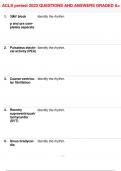
-
ACLS pretest 2023 QUESTIONS AND ANSWERS GRADED A+
- Exam (elaborations) • 22 pages • 2024
-
- $10.99
- + learn more
3ÚAV block p and qrs completely separate Identify the rhythm. 2. Pulseless electrical activity (PEA) Identify the rhythm. 3. Coarse ventricular fibrillation Identify the rhythm. 4. Reentry supraventricualr tachycardia (SVT) Identify the rhythm. 5. Sinus bradycardia Identify the rhythm

-
ACLS Practical Application - Section 3 of 3 in Pre-Course Assessment 2023 GRADED A+
- Exam (elaborations) • 5 pages • 2024
-
- $11.99
- + learn more
A patient has been resuscitated from cardiac arrest. During post-ROSC treatment, the patient becomes unresponsive, with the rhythm shown here (VT shown). Which action is indicated next? - ANSWER Give an immediate unsynchronized high-energy shock (defibrillation dose) After initiation of CPR and 1 shock for ventricular fibrillation, this rhythm is present on the rhythm check (vfib shown). A second shock is given, and chest compressions are resumed immediately. An IV is in place, and no drug...
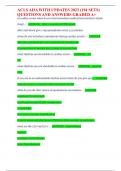
-
ACLS AHA WITH UPDATES 2023 (194 SETS) QUESTIONS AND ANSWERS GRADED A+
- Exam (elaborations) • 23 pages • 2024
-
- $12.99
- + learn more
in cardiac arrest when do you first introduce medical intervention? which drug? - ANSWER after 2 rounds of CPR/shock after 2nd shock give 1 mg epinephrine every 3-5 minutes when do you introduce amiodarone during cardiac arrest? - ANSWER after the 3rd shock give 300 mg bolus of amiodarone if second dose is needed give 150mg as second dose what rhythms are shockable in cardiac arrest - ANSWER VF VT what rhythms are not shockable in cardiac arrest - ANSWER asystole PEA if you are in an u...
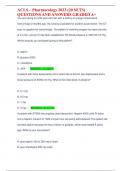
-
ACLS – Pharmacology 2023 (20 SETS) QUESTIONS AND ANSWERS GRADED A+
- Exam (elaborations) • 8 pages • 2024
-
- $11.99
- + learn more
You are caring for a 66-year-old man with a history of a large intracerebral hemorrhage 2 months ago. He is being evaluated for another acute stroke. The CT scan is negative for hemorrhage. The patient is receiving oxygen via nasal cannula at 2 L/min, and an IV has been established. His blood pressure is 180/100 mm Hg. Which drug do you anticipate giving to this patient? A. aspirin B. glucose (D50) C. nicardipine D. rtPA - ANSWER A. aspirin A patient with sinus bradycardia and a heart r...
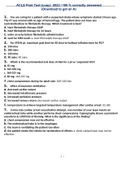
-
ACLS Post Test (copy) 2023 / 100 % correctly answered (Download to get an A)
- Exam (elaborations) • 6 pages • 2023
- Available in package deal
-
- $9.49
- + learn more
1. You are caring for a patient with a suspected stroke whose symptoms started 2 hours ago. The CT was normal with no sign of hemorrhage. The patient does not have any contraindications to fibrinolytic therapy. Which treatment is best? a. start fibrinolytic therapy ASAP b. hold fibrinolytic therapy for 24 hours c. order an echo before fibrinolytic administration d. wait for MRI result: a. start fibrinolytic therapy ASAP 2. For STEMI pt, maximum goal time for ED door-to-balloon-inflation tim...
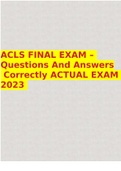
-
ACLS FINAL EXAM – Questions And Answers Correctly ACTUAL EXAM 2023
- Exam (elaborations) • 10 pages • 2023
-
- $10.99
- + learn more
ACLS FINAL EXAM – Questions And Answers Correctly ACTUAL EXAM 2023 A patient with suspected acute coronary syndromes (ACS) is placed on a cardiac monitor. The patient is complaining of dyspnea and is given supplemental oxygen. The provider determines that the oxygen is effective based on which SaO2 level? Correct ans - When a patient presents with potential ACS, the patient should have oxygen administered to maintain an SaO2 of at least 94%. A patient experiences cardiac arrest, and ...
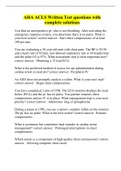
-
AHA ACLS Written Test questions with complete solutions
- Exam (elaborations) • 7 pages • 2023
-
- $10.49
- + learn more
You find an unresponsive pt. who is not breathing. After activating the emergency response system, you determine there is no pulse. What is your next action? correct answer: Start chest compressions of at least 100 per min. You are evaluating a 58 year old man with chest pain. The BP is 92/50 and a heart rate of 92/min, non-labored respiratory rate is 14 breaths/min and the pulse O2 is 97%. What assessment step is most important now? correct answer: Obtaining a 12 lead ECG. What is the p...
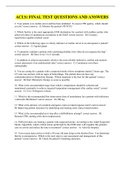
-
ACLS: FINAL TEST QUESTIONS AND ANSWERS
- Exam (elaborations) • 4 pages • 2023
- Available in package deal
-
- $10.49
- + learn more
2. Your patient is in cardiac arrest and has been intubated. To assess CPR quality, which should you do? correct answer: A) Monitor the patient's PETCO2 3. Which facility is the most appropriate EMS destination for a patient with sudden cardiac who achieved return of spontaneous circulation in the field? correct answer: D) Coronary reperfusion-capable medical center 4. Which of the following signs is a likely indicator of cardiac arrest in an unresponsive patient? correct answer: C) Ag...
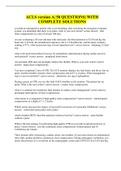
-
ACLS version A| 50 QUESTIONS| WITH COMPLETE SOLUTIONS
- Exam (elaborations) • 5 pages • 2023
- Available in package deal
-
- $10.99
- + learn more
you find an unresponsive patient who is not breathing. after activating the emergency response system, you determine that there is no pulse. what is your next action? correct answer: start chest compressions at a rate of at least 100/min. you are evaluating a 58-year-old man with chest pain. the blood pressure is 92/50 mm hg, the heart rate is 92/min, the nonlabored respiratory rate is 14 breaths/min, and the pulse oximetry reading is 97%. what assessment step is most important now? correct ...

Do you wonder why so many students wear nice clothes, have money to spare and enjoy tons of free time? Well, they sell on Stuvia! Imagine your study notes being downloaded a dozen times for $15 each. Every. Single. Day. Discover all about earning on Stuvia


